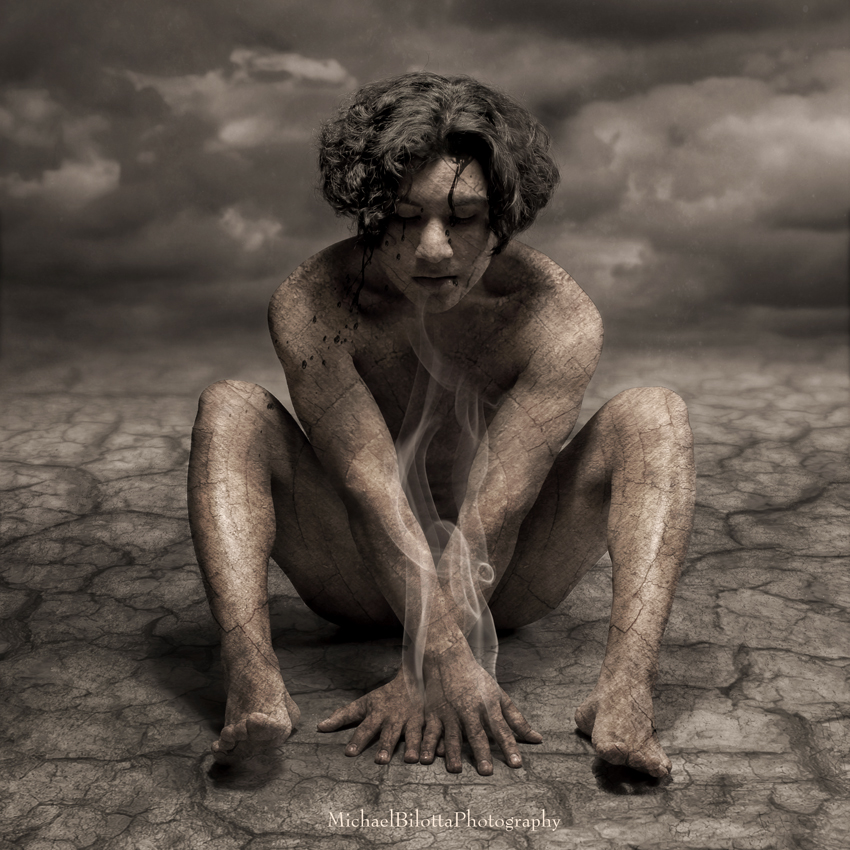the Beginning of Survival
This image was created in one day, short for me, but then, it is rather simple, and rightly so. There is always a push and pull within my creative impulses to be truthful and be "about" something, and also to entertain, not just other, but myself as well. Those two things need not be exclusive; some very flashy pieces are meaningful to me, even if I pulled out all the stops I could to make it pop a little louder. I liken it to American films - there are some that are big, loud and expensive looking, and others are quiet, personal or story-driven pieces that make their presence known not by the special effects, but by story and intent. All that to say, sometimes I enjoy producing larger than life, ostentatious pieces with hundreds of layers, and other times, I like to dial it down and get to something with some deeper meaning.
This piece is one of the latter. I knew what it was going to be as soon as I decided to use this raw model shot. Gilberto is one of my favorite models to use because, aside from being completely pleasant to work with and is up for anything, he also is quite versatile in appearance. His features can be many different cultures, and his hair, currently wild and getting longer, can appear timeless. He was a natural fit for this one because of all that.
One of my favorite artists and musicians is Joni Mitchell. In 1987 she wrote a song about the Lakota tribe and their plight in the modern world that really touched me. It was a passionate piece of writing with sharp, poignant lyrics told from the point of view of the Lakota themselves. Anyone growing up in the United States knows the real origins of our country, and how we took it piece by piece, and by force, from the indigenous peoples of this land. I am not an activist, I am not political, nor do I plan to be. I think we are well past the point of justice for the past atrocities committed, and what's done is done, sad as it is, but we are living in a time of great apathy, and revolutions, at least in this country, seem to be a thing of the past. That does not mean I cannot feel or empathize with these native americans, I do, I just don't think there is a repair coming or likely to come, ever.
So what can one do then? Well, all I ever feel I can offer is a point of view, as an archivist, as an artist, to compose things about something that is interesting or meaningful to me, and put it out into the world. Perhaps those of you who read this will consider these people for a few seconds, perhaps that's all that can occur. For myself, I try to relate a tragedy to my own life or sensibilities, and make it personal, because I do not care for political statements in the guise of art. I need to find a personal connection to it.
There are some lines from the song "Lakota" than run through my head often, it was such a great piece of writing, and so they immediately attached themselves to this piece as it came together. To me, the model seemed to be holding something back - an open wound or applying pressure to stop a leak of some kind. Lines from the song like:
Don't you hear the shrieking in the trees?
Everywhere you touch the earth--she's sore
Every time you skin her all things weep
It is something primordial and fundamental, and yet we of the modern world are literally taxing and even killing this planet, with money and politics driving that destructive machine. I do not hold myself apart from it - I am part of this culture too, but as I get older, I am more and more aware of how precious and fleeting life is, and how everything that lives can be killed. I have a greater respect for life now than i did in my brash youth, and now I hesitate when I kill an insect, and lately I do not, and now I consider a tree more than ever before if I think about breaking off a branch for whatever reason. It is one of the reasons I dislike large cities - the taming and demolition of nature, and yet, contradiction here - I am not a big outdoors person. I have been born into a way of living that is a means to a certain end, for all of us. I wish there was a glimmer of hope for repair, but I just don't see it, I really don't.
There was a letter or speech delivered by Chief Seattle to the white government in the mid 1800s, a concession to giving the land up, but also a plea to respect the land and value it - a warning of the ways he saw them treating the sacred land he was losing. I will post a link here if you are interested in researching it further, and there are many debates about the actual content of the speech, but one of the versions had this line that I really think spoke to not just this piece I did about the raping of the land, but also to the current state of our civilization as a whole:
The end of living, and the beginning of survival.
My piece was deliberately made to be open-ended. If you did not read this, hopefully it will mean something to you. I did not adorn the model with tell-tale Native American hallmarks, because, again, I wanted this to be about the land, and the sense of scorched and depleted earth, and with textures, show a connection to the man and the environment. To me, it could be also depicting someone who is surrounded by a desolation, a wilderness where nothing can grow, and he is mourning the loss of whatever used to grow there. Certainly we can all find something in our lives relatable to that feeling.
I will post a wiki link to Chief Seattle, and also, though about a different tribe, Joni Mitchell's wonderful song lyrics. I hope you enjoy them and are moved by them.
Chief Seattle: http://en.wikipedia.org/wiki/Chief_Seattle
Joni Mitchell's "Lakota:" http://www.lyricsfreak.com/j/joni+mitchell/lakota_20075282.html
Model: Gilberto Mendez
A Before and After version of this image can be seen on my Facebook page at: www.facebook.com/MichaelBilottaPhotography














BluesTime 24/09/2019 11:31
klasselg
el p 10/11/2013 2:56
very good! in fact better than very good!Sehr gut! in der Tat besser als sehr gut!